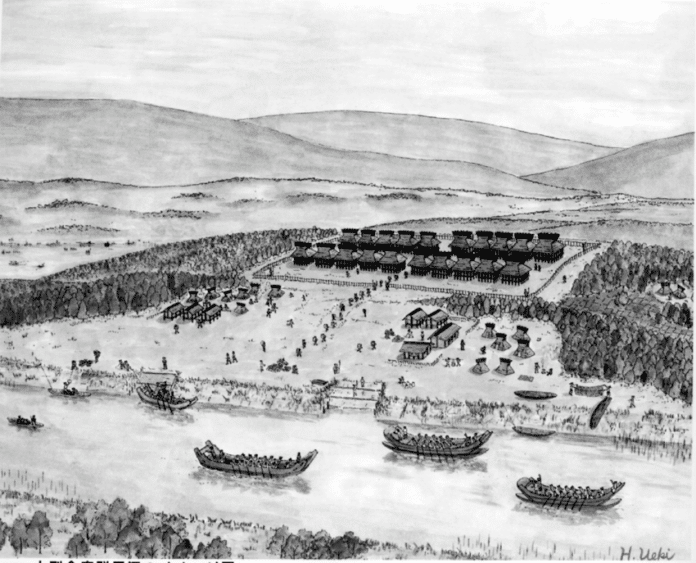
Mokarimakka? is one of the best-known phrases in Osaka-ben, the Japanese dialect native to Osaka. Literally meaning “are you making money?”, it is not necessarily a literal question about business, but is used as a greeting, to which the standard reply is bochi-bochi denna, or “so-so”.[1] This fits in with the widespread stereotype of Osaka people being preoccupied with money, and indeed Osaka has been known for many years as a major mercantile centre. As the business of buying and selling plays such a big role in the culture and society of Osaka, it is of course valuable to take a look at the city’s economic history. This essay will begin with a general overview, tracing Osaka’s history from the early port settlement of Naniwa, via the growing trade in the area during the mediaeval and early modern periods and the industrial boom of the twentieth century, to the relatively less prosperous city it is today. This chronological overview will be followed by sections focusing on specific industries: the development of banking, electronics and others. Before arriving at conclusions about Osaka’s economic history, there will be one more section looking at the surprising variety of innovations to have originated in Osaka, ranging from capsule hotels to instant noodles.
Table of Contents
Osaka’s changing economy
Osaka as we know it evolved from a mediaeval castle town, but the area where that town emerged had already been settled for hundreds of years. The earliest named settlements include Suminoe-no-tsu and Naniwa-zu, two port towns in the area between Osaka Castle and Sumiyoshi Grand Shrine today. They were most likely established from the 3rd to 5th centuries CE, with Suminoe-no-tsu probably appearing first.[2] At that time, the area’s geography was rather different from the way it looks today. The Uemachi Plateau, the elevated area that would later be the site of Osaka Castle, was between Osaka Bay – which no longer extends so far inland – and Kawachi Lake – a body of water covering what is now eastern Osaka.[3] In addition, this was where the Yodo and Yamato Rivers met the sea, making the site valuable for military vessels and for trade. The area had strong links to the world beyond Japan, particularly China and the Korean kingdoms of the time, and many major technological and cultural imports were brought there, including engineering, ceramics and religious teachings.[4] Suminoe-no-tsu in particular is said to have been Japan’s early link to the international Silk Road.[5] Later, the town of Naniwa-zu grew in importance, being used regularly for diplomatic and political purposes and even being chosen as the nation’s capital on multiple occasions. It was home to a major marketplace, and many merchants continued to do business there after the later diminution of Naniwa’s political significance.[6] As Naniwa’s time as the capital coincided with the introduction of new administrative laws in Japan, it was also the centre for taxation. Taxes and tributes in the form of rice and local products from different regions of ancient Japan were transported in and out of Naniwa, with some of these goods apparently remaining there even during times when the capital was situated elsewhere. Eventually, however, its centrality faded due to further relocations of the capital, and the shipping routes became less valuable as new canals made it possible to bypass Naniwa. There was still trade in the area, such as in the early mediaeval port of Watanabe-no-tsu, which served military and shipping purposes, but the centuries immediately following the decline of Naniwa were not characterised by prosperity in the area.[7]
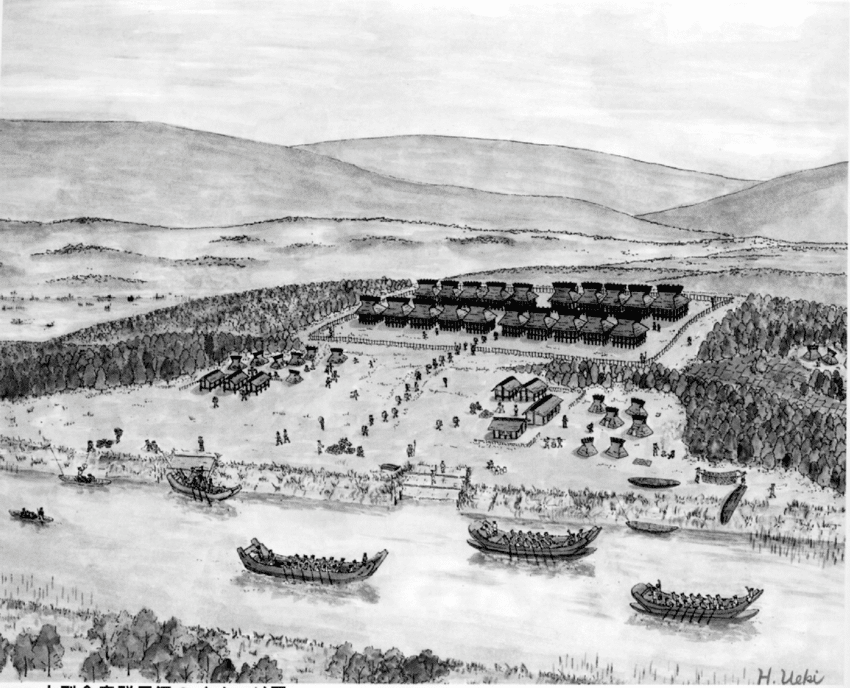
Source: Richard Pearson https://www.researchgate.net/publication/328203195_Osaka_Archaeology
Though the early settlements of Suminoe-no-tsu and Naniwa-zu faded away, the strategic benefits of the location remained, and after a while, the area became a bustling trading hub once again. The economic activity in the area that grew from around the 14th and 15th centuries CE was centred around the two newer towns of Sakai and Osaka. Sakai was remarkable in multiple ways: not only was its position at the intersection of the provinces of Settsu, Izumi and Kawachi convenient for enabling trade throughout the region, but it also came to be governed by a merchants’ council rather than the families ruling neighbouring areas.[8] It therefore earned a reputation as a “free city” that was relatively independent from the inter-clan warfare representative of that point in history. As well as being an increasingly important port for domestic trade, Sakai had connections with the world outside of Japan, engaging in international trade with the likes of the Ryukyu kingdom in modern-day Okinawa. Sakai also became a destination for many early Jesuit missionaries, who remarked on the city’s freedom, prosperity and safety.[9] However, despite this good reputation, Sakai was not free from the influence of warring clans: warriors had the wealth to be Sakai’s main patrons, and notably, the city’s greatest industries included arms and gunpowder.
While Sakai was one of Japan’s main commercial centres at the time, Osaka was only beginning to emerge. In the late 15th century, the temple of Ishiyama Honganji was founded in the former location of the palace of Naniwa, and around the temple a town called Osaka developed.[10] While the monks of Ishiyama Honganji resisted the attacks of warlord Oda Nobunaga, the town grew more prosperous, and soon became a major political centre after the temple fell and Osaka Castle was built in its place. Toyotomi Hideyoshi, who oversaw the construction of the castle in the late 16th century, was Oda Nobunaga’s successor, and one of the key figures in reuniting Japan after the long period of civil war. Much like Naniwa many centuries earlier, Osaka under Hideyoshi was the destination for taxes and home to many wealthy merchants, making it crucial to Hideyoshi’s administration.[11] New canals were constructed to further facilitate trade in Osaka, which earned a reputation as a commercial centre.[12] The cities of Sakai and Osaka both attracted merchants and artisans from elsewhere in Japan and abroad, increasing their fame as economic hubs and contributing to the development of arts and industries such as tea ceremony, dyeing and ceramics. This period marked the beginning of Osaka’s growth as “the nation’s kitchen”, which would only become more influential in the years that followed.
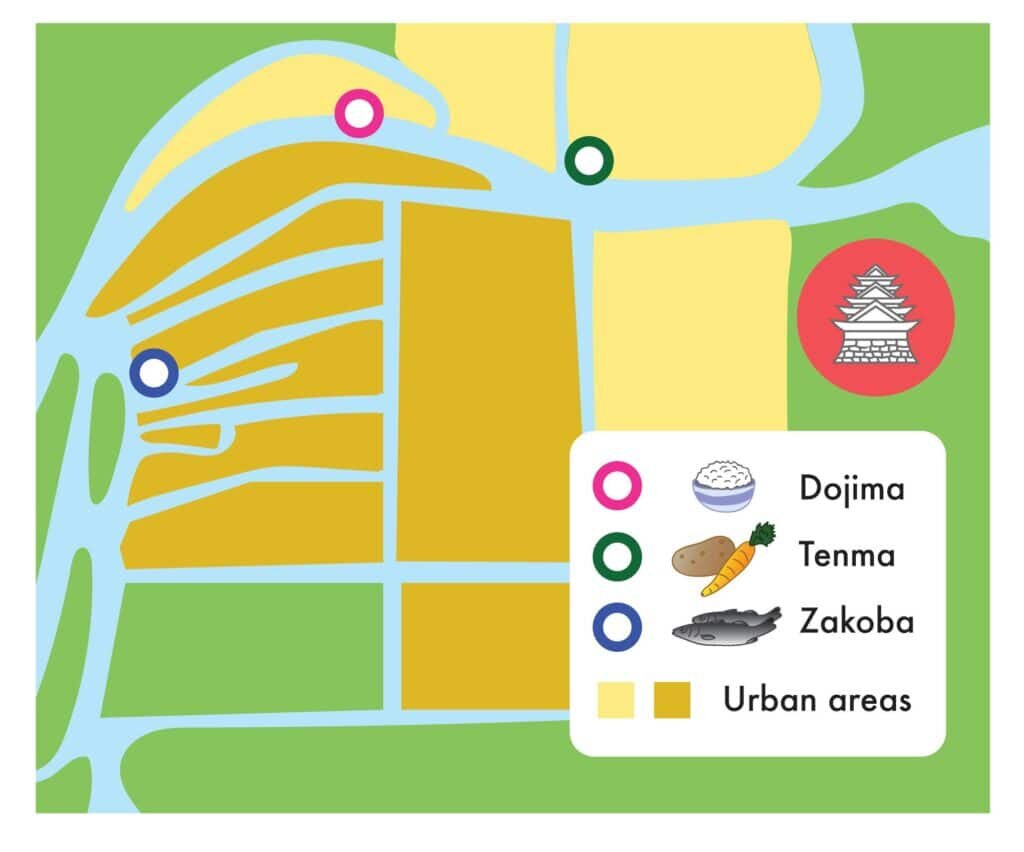
An important part of Toyotomi Hideyoshi’s legacy was a new class system. According to this Confucian-inspired system, there were four basic social classes: samurai, followed by farmers and peasants, then artisans, and with merchants at the bottom, while some people – such as priests or outcaste groups – were considered separate.[13] These hereditary castes were strictly divided, determining people’s living spaces and way of life, and theoretically preventing social mobility. Hideyoshi’s system remained even after his death at the end of the 16th century, and formed the social rules of the Edo Period, over two centuries of peace under the rule of Hideyoshi’s former rival Tokugawa Ieyasu and his descendants. Within the Edo Period government structure, Osaka was ruled directly by the Tokugawa clan in Edo – today’s Tokyo – via a specially appointed castellan.[14] Other cities administered in this way included Edo itself and Kyoto, which, together with Osaka, comprised the three great cities of Edo Period Japan, each with their own distinctive qualities. Kyoto, the traditional capital, was associated with court nobility and culture, Edo, the de facto capital, was dominated by samurai, while in contrast, Osaka had an unusually high population belonging to the merchant class.[15] During the Edo Period, these merchants became extremely influential despite the strict social hierarchy, but also in a sense because of it: though their position was low in theory, they had the unique opportunity to make profit, which was considered inappropriate for those of higher classes.[16] Osaka, home to so many merchants, became even more suited to trade with the construction of more waterways and the development of major markets. In particular, the Dojima Rice Market, Tenma Vegetable Market and Zakoba Fish Market facilitated the flow of money and contributed to Osaka’s growing association with cuisine.[17] This all resulted in Osaka becoming a major economic centre in Japan, with many of the ruling samurai class ending up indebted to Osaka merchants. By the end of the Edo Period in 1868, Osaka was among the country’s wealthiest cities.
The Meiji Restoration, which ended the military government of the Edo Period, reinstated the authority of the emperor and ushered in Japan’s modern age, saw the official relocation of the capital from Kyoto to Edo.[18] Edo, then renamed Tokyo, had already been growing economically, and once it was designated as the capital of an increasingly centralised nation, it became the dominant city in Japan. This meant that, compared with the heady days of the Edo Period, Osaka struggled at the beginning of the new era. However, though Osaka’s merchants could no longer rely on traditional styles of trade, industrialisation offered a means to revive the city. Industries including machinery, shipbuilding and textiles developed in Osaka, and important national facilities such as the Mint Bureau and the Osaka Army Arsenal were established there.[19] In 1903, the Tennoji area of Osaka was the host of the last – and largest – National Industrial Exposition, an event for promoting industry which featured exhibits from other countries for the first time.[20] The city’s growth during this time was such that in the mid-1920s, after the Great Kanto Earthquake led to a wave of migrants from Tokyo to Osaka, the population of Osaka overtook the capital’s for the first time in modern history. Comparisons with other major cities internationally suggest that it was the world’s sixth-most populous city at the time, with over 2 million residents.[21]

Source: Mainichi Japan https://mainichi.jp/articles/20160414/ddl/k27/040/458000c
Osaka continued to be a major site of industry in the interwar years. Japan’s imperialist project was in full swing during this time, and the military was increasingly deployed on the Asian mainland. As overseas colonies were being developed, this also meant that many workers moved – often unwillingly – to Japan. Osaka was one of the main destinations for people from Okinawa, which had been made a Japanese prefecture in 1879, and Korea, formally annexed in 1910.[22] Upon arrival in Osaka, many worked in factories, playing an important role in Japanese industry while also suffering from discrimination in many forms. Meanwhile, a major industry in interwar Osaka was munitions, based around the Osaka Army Arsenal, which had been established on the site of Osaka Castle in 1870.[23] Prior to and during the Second World War, many industries were focused on production for military applications, with steel and chemical companies especially having close ties to the Arsenal. The Osaka Army Arsenal’s production increased significantly during the 1930s and was one of the country’s largest armouries.[24] However, this also made it a major target in the Second World War, and indeed it was destroyed during the final days of the war. The war had a great impact on Osaka as a whole, as the city was severely affected by bombing, causing its population to plummet from what had been an all-time peak of over 3 million.[25] Partly as a result of the loss of life and of the war industry, the story of postwar Osaka is rather different from what it was before.
The Japanese economy was hit hard by the Second World War, but after an initial setback, the country recovered quickly. Administrative reforms and the renewed importation of ideas and technologies from the rest of the world enabled a period of astonishing growth known as the “postwar miracle”.[26] Of course, Osaka benefited from this growth too, but for the most part, the modern trend towards centralisation in the capital continued during the postwar era. Famous highlights for Osaka include the 1970 World Expo, a huge international event that welcomed millions of visitors and is remembered as a symbol of Japan’s postwar economic success. However, the years since have seen Osaka move further into Tokyo’s shadow.[27] Heavy industry, once a key part of Osaka’s economy, suffered after an initial revival, due to the increasing problem of pollution.[28] This was nothing new – Osaka had been uncharitably dubbed “the city of smoke” as early as the late 19th century – but at this time it became a major social issue, leading community organisations and politicians to begin promoting new environmental protection measures in the 1970s. At the same time, manufacturing declined as companies moved overseas and to Tokyo. One result of Osaka’s economic stagnation relative to the capital has been increasing regionalism in politics. The most visible form of this has been the rise of Osaka Ishin no Kai, a local party that has dominated the Osaka political scene in the 2010s, seeking to gain greater autonomy from Tokyo and to make Osaka the “vice capital” of Japan.[29] Until recently, their signature policy was the Osaka Metropolis Plan, which would have reorganised Osaka’s administrative wards into four “special wards” similar to Tokyo, but the plan was narrowly defeated.[30] The party’s other strategies for boosting Osaka’s flagging economy have continued a pattern that developed in the past few decades. Derided by opponents as “festival economics”, this revolves around hosting large-scale events along the lines of the fondly-remembered Expo ’70 and the relatively lowkey Horticultural Exposition of 1990, in hopes of stimulating local activity as well as tourism. After a failed bid for the Olympic Games, Osaka eventually succeeded in bringing back the World Expo, which will be held again in Osaka in 2025.[31] While organising such a high-profile event will surely draw attention to Osaka, there is still scepticism about the effectiveness of this approach. It remains to be seen whether the 2025 exposition will manage to do what even Expo ’70 could not, and turn the tide of the postwar shift towards Tokyo.
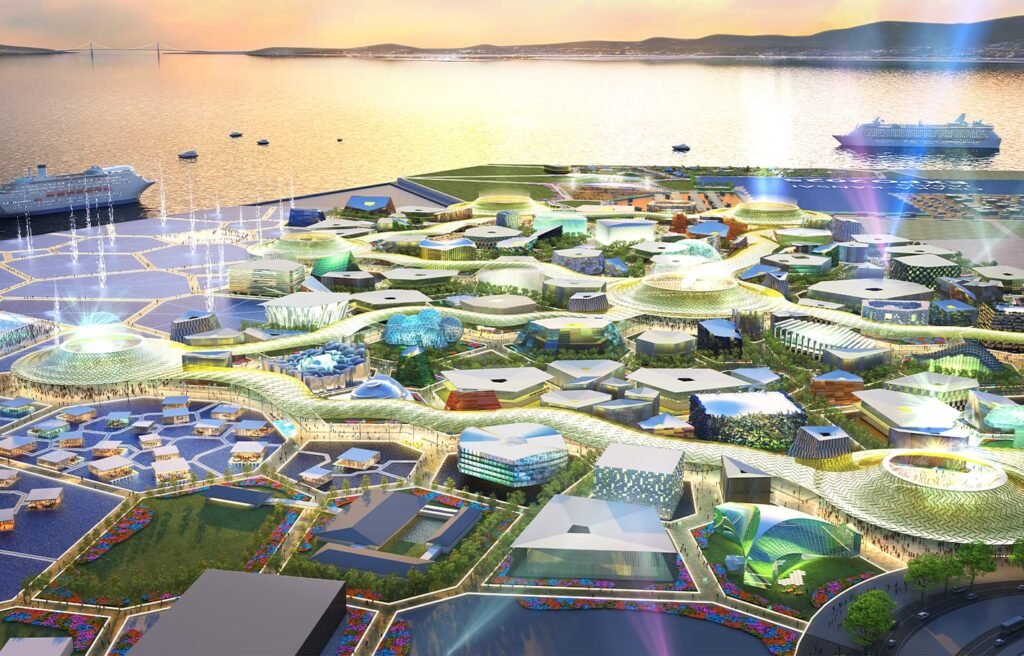
Source: Japan Association for the 2025 World Exposition https://www.expo2025.or.jp/en/
At several point in Osaka’s past, it has been Japan’s principle commercial centre: when it was home to international ports and the national capital in ancient Japan, and again as a mercantile hub in the Edo Period and as an industrial city for much of the 20th century. The geography of the area has played an important part in this, especially with the aid of waterways built throughout Osaka’s history. The restructuring of Japanese society in the 16th century was also significant, as it created what became the ideal environment for Osaka’s many merchants to amass wealth. Perhaps this mercantile history is what gave people the necessary flexible attitude to find a new direction for Osaka after the Meiji Restoration. On the other hand, the postwar situation appears to have been more difficult to handle, with the capital of Tokyo becoming so economically dominant. Today, the most visible efforts to jump-start Osaka’s stagnant economy have involved expensive, headline-making projects, which have been criticised for failing to address more fundamental issues. However, as bleak as it may seem when looking at the overall economic situation, later sections will show that Osaka has made some important economic contributions in recent history, and that there are still reasons to be optimistic.
The origins of banking in Japan
As explained above, Osaka developed rapidly as a trading city during the Edo Period, contrasting with Kyoto and Edo due to its high population of merchants. It became famous as the commercial centre of the country, and over time, this came to means not only the buying and selling of goods, but also more sophisticated financial systems. In the first of two sections examining industries and organisations in closer detail, here we will look at how Osaka’s commercial institutions – especially the Dojima Rice Market – became important systems for finance in Japan and laid the groundwork for the country’s banking system. This section will also describe some of the specialised financial agents that emerged, as well as the background of modern financial institutions in Osaka, including the Mint Bureau.
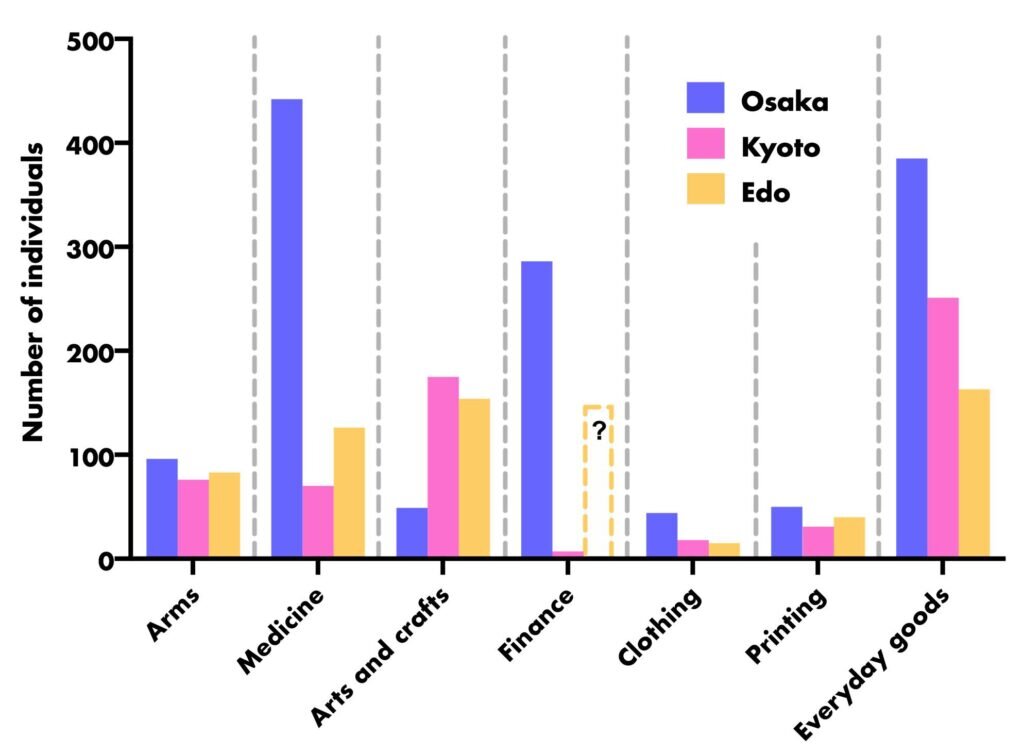
A great deal of trade was conducted via Osaka in the Edo Period, on both regional and national levels. Production was also high, and the industries that boomed there were largely reflective of Osaka’s demographic makeup: compared with other major cities where production was focused more on luxury items, goods in Osaka catered largely towards mass consumption by urban residents.[32] Major industries included textiles, lamp oil, medicine and printing. Besides these varied industries, another important commodity at that time was rice. Rice was not only valuable as a staple food, but also as a form of currency, having been used for taxation and payment for centuries; this included the system by which the value of feudal domains was assessed, and how local lords taxed the peasantry.[33] Lords received taxes in the form of rice, and any rice that they did not need personally was used for trade. Osaka, as a central city with strong trade networks, became the main destination for rice that lords wanted to sell, and many of them kept warehouses there to facilitate business. Osaka’s major role in the rice trade was crucial in establishing the city as a commercial hub.
If Osaka was the centre of Japan’s rice trade, then the centre of Osaka’s rice trade was the Dojima Rice Market. The origin of the market lies in trade that took place in and around the trading house of a merchant named Yodoya Saburaemon in the 17th century.[34] By that point, Osaka was already the main destination for feudal lords’ rice shipments, and local merchants were paid to manage warehouses. Lords had begun issuing “rice bills” to overcome the changeability of rice harvests and prices, and maintain a steady income flow; these bills were soon traded among Osaka merchants at Yodoya’s house. By the end of the century, the location moved and a formal market was established on the island of Dojima, situated in an area a little to the south of today’s Umeda district. There are a few possible reasons for the relocation of the market. For one thing, the level of activity outside Yodoya’s trading house caused congestion; for another, the military government was suspicious of the trade going on, believing that it amounted to gambling and was likely to drive up rice prices.[35] Yodoya himself tended to get on the wrong side of the authorities, becoming famous for his incredible – and often ostentatious – wealth, which would later result in his assets being confiscated by the government. However, in spite of repeated crackdowns on the speculative trading of rice bills, the practice continued illicitly, and in 1715, it was officially permitted at Dojima, out of a hope that this business would increase rice prices again after several years of decline. This was a significant development that resulted in Dojima Rice Market being cited today as the first futures exchange not only in Japan but in the entire world.[36] The market even developed surprisingly sophisticated mechanisms for trade, including credit houses and clearing houses. The establishment of such a complex financial institution was an important early step in what would evolve into the banking system of Japan.
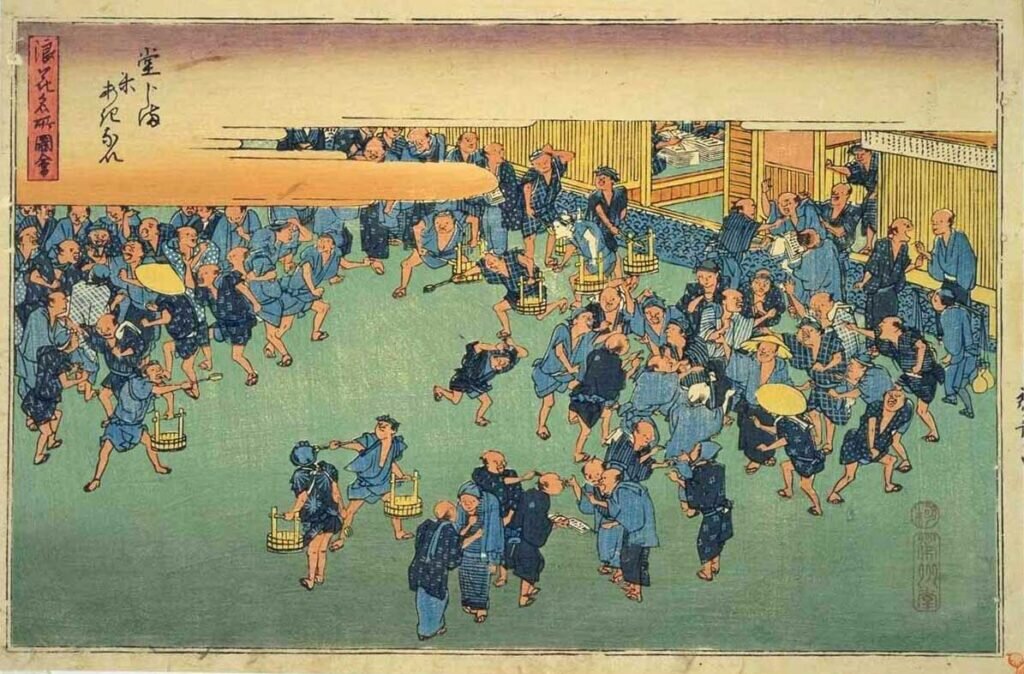
Source: Hiroshige.org.uk https://www.hiroshige.org.uk/Other_Views_Scenes/Other_Views_Scenes.htm
In addition to, and often in connection with, the Dojima Rice Market and the rice brokers who operated there, other kinds of financial agents emerged during the Edo Period. These included money changers, or ryogae, who would perform services such as providing loans and exchanging different kinds of currency.[37] This was necessary because at that time, the coins used in different parts of the country varied, with Edo and nearby areas using gold coins preferred by the government, and western Japan including Osaka tending towards the use of silver; several forms of paper currency also came into use. Ryogae, who in many cases acted as de facto bankers, first appeared some time before developments like futures trading at the Dojima Rice Market, and they continued to be important throughout the Edo Period in Osaka, Edo and around the country. In the 17th century, Osaka’s most powerful ryogae known as the Big Ten made up what was effectively the first organised banking system in the country, handling government business and controlling the gold and silver markets.[38] Financial agents were powerful during the Edo Period, amassing wealth and exercising authority by providing essential services to those of the samurai class, who were often indebted to Osaka merchants. However, this also resulted in resentment and efforts by the government to restrict merchants’ activities. The later growth of commercial activities in Edo began to outshine Osaka towards the end of the Edo Period, and this was another contributing factor to Osaka’s decline.
When banks were formally established early in Japan’s modern era, they did not necessarily grow organically from the country’s existing financial institutions. Rather, the new government experimented with Western-style banking as a means of modernisation, such as by imitating European and American models to form a national bank.[39] This occurred alongside an overall tendency towards centralisation of politics and governance, and so the focus was in the new capital of Tokyo. There were also foreign banks conducting business in port cities like Yokohama and Nagasaki, which were among the first places to be opened to foreign trade. Although much of Japan’s early banking system was associated with new foreign influences, the institutions that had evolved over the previous centuries still had a role to play: several of the Japanese banks that were established during this time had their origins in major ryogae families, including Mitsui, Sumitomo and Nomura.[40] Both of the last two have an Osaka background. Sumitomo began life as a medicine business in Kyoto in the 17th century, before relocating to Osaka a generation later and expanding into industries including copper mining and financial services.[41] Today, the Sumitomo Group is among Japan’s biggest business conglomerates. Whereas Sumitomo has existed since early in the Edo Period, Nomura goes back to just before the beginning of the modern era, and crucially, just before money changers became obsolete.[42] The son of a ryogae agent named Nomura pushed his father’s business towards banking and later founded Nomura Securities. The examples of Sumitomo and Nomura show that though Japan’s modern banking system was largely based on new ideas, the financial agents of the Edo Period and their descendants were still important to its development.
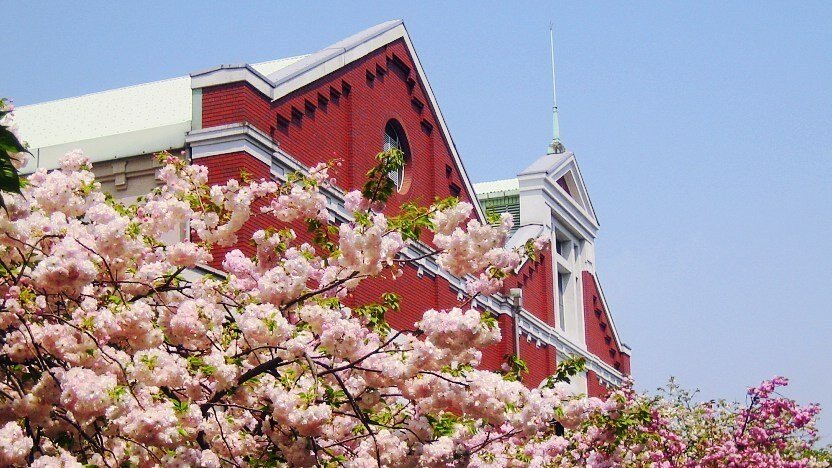
Source: Japan Guide https://www.japan-guide.com/e/e4008.html
New economic institutions in the modern era were largely based in Tokyo, but one notable exception is the Mint Bureau. The mint was established in 1871, as an important early step in the Japanese government’s efforts to modernise the country.[43] The aim was to regularise coinage in Japan after many centuries of decentralisation. Suggested reasons for the mint being founded in Osaka rather than Tokyo or elsewhere include concerns over public order in Tokyo, the then-recent proposals by some that Osaka should be the new capital, and an attempt to repay Osaka merchants whose financial backing the new government required in order to carry out its far-reaching reforms.[44] Whatever the precise reasoning, it seems that Osaka’s reputation as a mercantile centre was important. As with many public works projects at the time, Westerners were heavily involved in the building of the mint. British machinery was imported to Osaka from Hong Kong, and a group of British architects and engineers were employed to plan and carry out the construction.[45] Godai Tomoatsu, a businessman from Kyushu who had studied in London, was involved in organising the project and hiring the engineers. He soon contributed further to the commercial world of Osaka as head of the city’s Customs Department and, later, as a founder of the Osaka Chamber of Commerce and Osaka Stock Exchange.[46] Thanks to the efforts of Godai and others, the Mint Bureau was important in Japan’s modernisation and helped keep Osaka at the centre of the nation’s commercial activities. Together with the Edo Period history of innovative financial systems and the success of huge companies that evolved from Osaka ryogae businesses, the Mint Bureau is a sign of the influence of Osaka’s mercantile culture on modern banking in Japan.
Selected industries in Osaka
Over the centuries, a number of industries have prospered in the commercial city of Osaka. As mentioned above, historically these included the likes of textiles, ceramics and shipbuilding; in more recent years, some of Osaka’s major industries have been chemical products, pharmaceuticals and steel.[47] To go into detail on the background of all of Osaka’s industries would be a huge undertaking, as they are so varied, but this section will look at a small selection in order to give some insight on their historical significance and to point out some tendencies that apply to many businesses in Osaka and in Japan in general. The areas chosen in this case are construction, railway companies, electronics and alcoholic beverages.
As one of Japan’s foremost urban areas for centuries, it is only natural that the construction industry should be important to Osaka. Early examples of construction companies in Osaka include some of the oldest in Japan. In the late 6th century CE, Shitennoji was built on the orders of the regent Prince Shotoku, making it Japan’s first officially commissioned Buddhist temple.[48] The carpenters responsible for building the temple were among the many Koreans in Naniwa who brought new forms of technology and learning from the kingdom of Baekje. One of the carpenters soon founded Kongo Gumi, which went on to be the world’s longest continuously operated business of any kind.[49] The company was run as a family business which worked on several other important Buddhist temples, as well as projects like Osaka Castle. Unfortunately, after over 1400 years of uninterrupted private operation, it was finally taken over by Takamatsu Construction Group, a much newer Osaka company, in 2006.[50] In this form, Kongo Gumi continues to work in the area of temple and shrine construction.

In Japan today, the biggest construction contractors are known as the Big Five: these are Kajima, Obayashi, Taisei, Shimizu and Takenaka.[51] Of these five, one was originally founded in Osaka, while another moved its headquarters to Osaka from Nagoya in the 20th century. The former, Obayashi, was established in Osaka in 1892 when its founder won a contract to build a paper mill.[52] The company soon developed a reputation nationally, and throughout the 20th century, Obayashi worked on a variety of high-profile projects including Tokyo Station and Koshien Baseball Stadium.[53] Though Obayashi is perhaps the most successful construction company founded in Osaka, it ultimately followed the same pattern as many others in the last few decades, in moving the corporate headquarters to Tokyo in 2010.[54] The other Big Five contractor with an Osaka connection is Takenaka. In 1610, the company was founded in Nagoya, by a former construction magistrate who had struggled for work in the years after the death of his master Oda Nobunaga and eventually turned to carpentry.[55] Like Kongo Gumi, his main focus was on shrine and temple construction. In the modern era, the company opened local offices in Tokyo and the Kansai area, and moved the main office to Osaka in 1923.[56] Despite being the smallest of the Big Five companies, they hire many architects and today have a good reputation for design. The existence of major firms like these is a sign of the importance of the construction industry to Osaka, but this can also be seen in some of the city’s social problems, including pollution, as mentioned above, and homelessness. One of the country’s most infamous slum areas grew as a side effect of the construction of the Shinsekai district.[57] This large-scale building project, which included Tsutenkaku, a famous symbol of Osaka, required huge numbers of day labourers who were housed just south of Shinsekai and then remained there in poverty after their employment dried up. The slum area developed from there, soon affecting the reputation of Shinsekai itself; homelessness remains a significant issue in that part of the city today. In this respect, the construction industry reveals both good and bad sides to Osaka’s history.
Closely related to construction is railways, another big industry in Japan. A noticeable difference between Osaka and Tokyo is the number and prominence of private railway companies in the Kansai area – including Osaka.[58] The first of these to be founded was Nankai Electric Railway, which began operation in 1885 as Japan’s first purely private rail company.[59] Based in Namba, where the area around Dotonbori had long thrived as a central business district in Osaka, Nankai opened the Nankai Building there in 1932, ushering in further development of this shopping area with the inclusion of the Takashimaya department store.[60] The terminal building, with its curved forms and archways, became symbolic of southern Osaka City, leading to its recognition in 2011 as a Tangible Cultural Property of Japan.[61] While Nankai has long served the south of Osaka, including with an airport connection after the 1994 establishment of Kansai International Airport, Osaka’s most famous private railways are probably two in the north of the city: Hanshin and Hankyu. These two are especially notable for the business diversification used by many railway companies – including Nankai and others in Osaka like Keihan and Kintetsu – to subsidise their operations.[62]
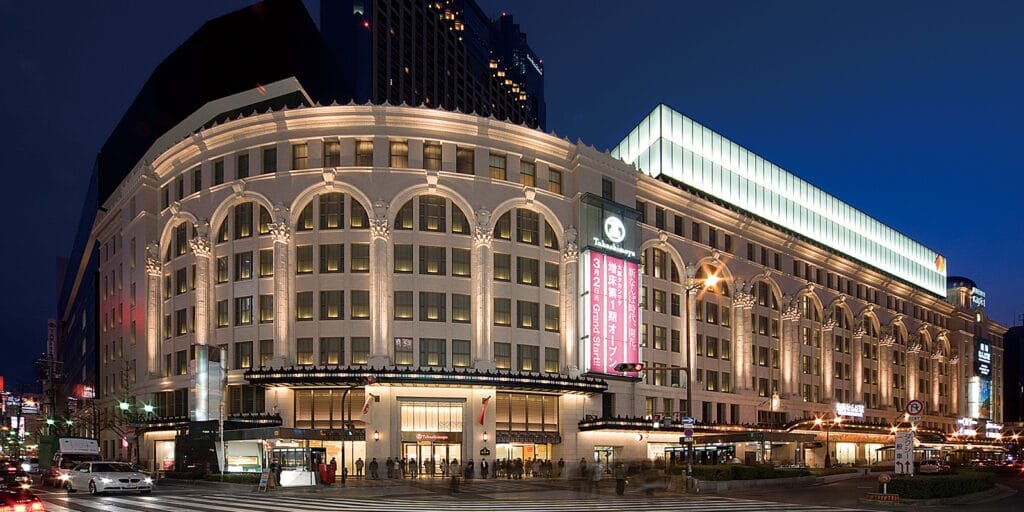
Source: Plantec Architects https://plantec.co.jp/project/nankai01/?lang=en
Hanshin Electric Railway started business in 1899 and opened their first line in 1905, running between Osaka and Kobe.[63] They did this by exploiting a loophole in the rule against private railway companies competing with government-run services, which allowed for the construction of a “tramway” serving local communities. Hanshin therefore built a deliberately indirect line that could reach many potential passengers, unlike the direct route used by the national railway. A few years later, Imanishi Rinzaburo took over as manager of Hanshin, and quickly oversaw projects to expand business, including the development of Koroen Amusement Park in Nishinomiya and involvement in housing development in the suburban areas between Osaka and Kobe.[64] The amusement park lasted for only a few years, but Hanshin enjoyed great success with developing the area, and later ventures such as the opening of Koshien Stadium in 1924. The stadium, Asia’s biggest at the time, was constructed to host high school baseball tournaments, which have become a huge cultural phenomenon.[65] In 1935, it also began to be used as the home stadium of the Tigers, a baseball team still owned by Hanshin that is strongly connected with Osaka and enjoys greater support than any other team in Japan, even today after decades of lacklustre results.[66] While opening amusement parks and owning baseball teams may seem like surprising enterprises for a railway company, this is actually not unusual in Japan, as demonstrated by Hanshin’s old rivals, Hankyu.
Hankyu started out as the Minoh-Arima Electric Railway in 1907 when Hankaku, another railway company that was later nationalised, took advantage of the same loophole as Hanshin to operate from the developing Umeda Station in Osaka and serve existing hot spring towns north of the city.[67] In charge was businessman Kobayashi Ichizo, who decided not to focus on Arima – north of Kobe – and to instead attract customers to Takarazuka, which is closer to Osaka. Driven to outdo Hanshin, Kobayashi also developed the suburban areas between Osaka and Kobe and opened an amusement park. Only a few years after the company began operation, one of Hankyu’s most influential ventures was born, in the form of the Takarazuka Revue, an all-female musical theatre troupe.[68] The revue became a major phenomenon and cultivated a devoted fanbase, inspiring many imitators in over a century of operation. Kobayashi did not stop with the Takarazuka Revue, however, exploring more new enterprises in the following decades. In 1929, Hankyu had great success with the opening of the Hankyu Department Store at their station in Umeda, starting a trend of combining railway stations with department stores that quickly became standard practice throughout the country. A few years later, Kobayashi founded the Tokyo-Takarazuka Theatre Corporation to manage the theatre in Takarazuka and several others that he had acquired; after absorbing some film production studios, this became the Toho Motion Picture Company.[69] Toho is known as one of Japan’s leading film production companies, famous for Godzilla and the works of Kurosawa Akira, among many more. Unlike rivals Hanshin, Hankyu’s business endeavours have generally had a more highbrow tendency, reflecting – and likely also contributing to – contrasting public images of the two. Interestingly, since 2006, they have no longer been rivals.[70] Today, both Hankyu and Hanshin, together with Toho and a whole host of companies in many different industries, are together part of the Hankyu Hanshin Toho Group.[71] The development of such a huge business group based originally on railway companies shows the immense potential of the business models pioneered by the likes of Nankai, Hanshin and Hankyu. This has enabled these companies to remain in business for over one hundred years, and prepared them for branching out further in response to contemporary challenges like depopulation.[72]
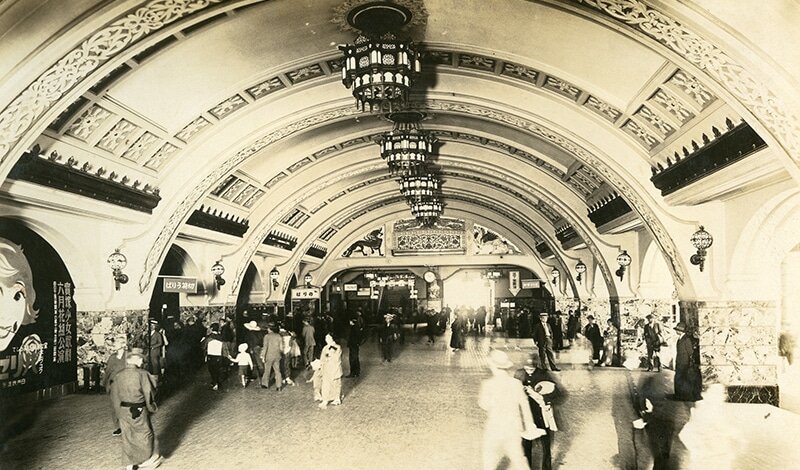
Source: Junior Chamber International Osaka https://www.osaka-jc.or.jp/2018/activity/special-project/464/
Osaka is also home to big names in Japan’s world-famous consumer electronics industry, particularly Panasonic and Sharp. Panasonic, based northeast of Osaka City in Kadoma, is comparable to Hankyu in that its early success was driven largely by one innovative individual.[73] At the age of 23, Matsushita Konosuke founded the company in Osaka in 1918, and as Matsushita Electric, the small company initially produced light sockets before moving on to other electrical goods, aiming to offer low prices. Among the company’s early successes was the 1927 release of a battery-powered bicycle lamp, which marked the first time Matsushita used the name “National”, a brand used for many of their products over the years.[74] The “Panasonic” brand name did not appear until the 1950s, when it was introduced for exported products due to “National” already being in use in North America under another manufacturer.[75] Using several brand names, Matsushita Electric became a huge organisation internationally, investing in and acquiring other companies including Sanyo, another major name in electronics that had been founded after the Second World War by Matsushita Konosuke’s brother-in-law.[76] Though it may seem surprising given the ubiquity of the Panasonic brand name during the peak of Japan’s dominance of the global electronics market, the company itself was still Matsushita Electric until 2008, when it was changed to Panasonic Corporation to unify the company’s brand identity.[77]
Like Panasonic, Sharp was guided by its entrepreneurial founder, but unlike Matsushita Konosuke, Hayakawa Tokuji started his company in 1912 as a metalworking business in Tokyo.[78] With his brother, Hayakawa developed inventions such as a belt buckle without perforations, and an innovative mechanical pencil known as the Sharp Pencil – a name that has since become the generic term for mechanical pencils in Japanese. Hayakawa was one of many who left Tokyo for Osaka after the Great Kanto Earthquake of 1923; in the destruction, he lost his wife, his young children and his company’s factory, and he endeavoured to start afresh in Osaka. There, the company manufactured radios using the “Sharp” brand popularised by their pencils, and transitioned into an electronics business.[79] The company grew and became known for other innovative products including the world’s first LCD calculator in 1973 and the first camera phone in 2000.[80] As with many Japanese electronics companies in Osaka and elsewhere, Sharp’s success declined in the 21st century, eventually leading to the company becoming a subsidiary of Taiwanese manufacturer Hon Hai and the headquarters being moved from a central Osaka City location to Sakai in recent years.[81]

Source: Sharp https://global.sharp/corporate/info/his/only_one/item/t13.html
While household electronics of the kind that Panasonic and Sharp made their name on may not be the guaranteed money-makers they once were, another area of electronics with a foot in Osaka is the huge industry of video games. Several video games developers and publishers are based in Osaka, but perhaps the best known are two big names in arcade gaming, SNK and Capcom. Shin Nihon Kikaku – later called SNK – was founded in the 1970s by Kawasaki Eikichi, originally to produce components, but they soon moved into making their own coin-operated arcade games.[82] During the 1980s they achieved success in arcade gaming and in home versions on the Nintendo Entertainment System (NES), which survived relatively comfortably after the 1983 home gaming crash in North America. Meanwhile, Capcom, renamed from IRM Corporation in 1983, also developed popular games for arcades and the NES.[83] Moving into the 1990s, both companies flourished further, with SNK introducing the NeoGeo MVS, an arcade cabinet with changeable game cartridges, and Capcom following up a fairly minor late-80s arcade title with the enormous hit Street Fighter II. SNK developed a reputation for creating challenging, high-quality games that appealed to serious arcade gamers, for example with the release of an expensive home version of the NeoGeo, and fighting games like King of Fighters that competed with Capcom’s Street Fighter series.[84] However, while Capcom went from strength to strength at the end of the 1990s and the new millennium, SNK struggled before going out of business in 2001. Kawasaki then started a new company called Playmore and reacquired SNK’s properties from the pachinko manufacturer that had taken over his old company; eventually the new company was able to change its name from SNK Playmore back to SNK.[85] Meanwhile, Capcom has remained a huge force in the industry, recently recording record profits for three consecutive years.[86] The fact that these two major video game companies started in Osaka and remain there today shows Osaka’s relevance even in newer industries.
Since the Edo Period, Osaka has been known as “the nation’s kitchen”, with the city and its people strongly associated with food. Therefore, it makes sense that drink, as well as food, is consumed widely in Osaka; today, Osaka Prefecture is near the top of the list for highest consumption of beer in Japan.[87] Of course, beer was not always produced in Japan, and traditionally the main alcoholic beverage was sake. Sake, which has been brewed in Japan since before recorded history, was one of Osaka’s big exports in the Edo Period, much of it being brewed in the towns of Ikeda and Itami to the north of Osaka.[88] The sake shipped from Osaka was so well-regarded for its quality that a significant majority of sake consumed in Edo came from there.[89] Osaka’s strength in this industry came about due to its abundant sources of water and rice, as well as innovative brewing techniques and Osaka’s status as a trading city more generally. Towards the end of the Edo Period, sake delivered from Osaka continued to be popular, but its main source shifted westwards from Ikeda and Itami to the Nada region, then also part of Settsu Province, but today in eastern Hyogo Prefecture.[90] However, since the end of the Edo Period, sake production in Osaka has declined dramatically, and now Ikeda – once the place where the most famous sake was produced – has only one brewery remaining.[91] This is not so strange, as after industrialisation, Osaka no longer had a reputation for clean water and plentiful rice, while less urbanised areas like Nada grew to fill that gap. Sake is also less popular in Osaka now: the average sake consumption per person in Osaka Prefecture is among the lowest in Japan, in stark contrast with the consumption of Western beverages like beer, whisky and wine.[92]

When it comes to Western drinks, Osaka’s history is important not only in terms of consumption but also production. A crucial early date was 1889, when the Osaka Beer Brewing Company was established to produce beer catering to Japanese tastes, culminating in the 1892 launch of Asahi Beer.[93] The brewery in Suita, north of Osaka City, was the second-biggest in Japan at the time, and the new beer proved popular.[94] High taxes confined the industry to only the biggest producers for many years, among which Asahi continued to compete, but generally the company lagged behind their main rival, Kirin. However, in the 1980s, at the height of Kirin’s market dominance, Asahi unveiled the game-changing Super Dry beer, dramatically increasing their market share and even influencing brewers overseas. Today, as well as being the biggest of Japan’s major brewers, the Asahi Group produces other food and drinks, and owns a number of European brewing companies too.[95] Osaka’s other big producer of alcoholic beverages is Suntory, which has its roots in Torii Shoten, established by Torii Shinjiro in 1899.[96] The company’s first big success was Akadama Port Wine, a fortified wine drink introduced in 1907, but ultimately Torii was not satisfied with only selling wine. He changed the company’s name to Kotobukiya, and in 1923, he hired Taketsuru Masataka, who had spent two years in Scotland learning how to make a drink that Torii wanted to bring to Japan: whisky.[97] While Taketsuru argued that Hokkaido’s northern climate would be better suited to whisky distilling, Torii preferred the Kansai area in order to reduce shipping costs, resulting in the founding of Yamazaki, Japan’s first whisky distillery, on the border between Osaka and Kyoto Prefectures.[98] Taketsuru would later go independent and found a distillery in Hokkaido after all, producing Nikka Whisky, a brand now owned by Asahi.[99] Meanwhile, Kotobukiya – Suntory from 1963 – expanded throughout the 20th century, opening more whisky distilleries and introducing other beverages including beer and soft drinks. Suntory also grew by acquiring other companies, creating a global network of major brands. This reached new heights with the 2014 acquisition of Beam Inc, owners of Jim Beam and other spirits brands, turning Suntory into one of the world’s largest drinks companies.[100] Suntory continues to be based in Osaka today, but as previous examples have shown, this is an exception to the rule, with Asahi being another major company to move to Tokyo after the Second World War.[101] However, the innovations brought by both of these companies had a great impact, and they remain strong today, even though businesses in several other industries have struggled in recent times.
Some of the recurring themes in the stories of Osaka’s famous businesses are entrepreneurship, innovation and a willingness to expand beyond a single industry. These qualities can of course be seen in many companies in Japan, but it is tempting to imagine a clear connection between the proud merchants of the Edo Period and the visionary figures that drove the likes of Hankyu and Panasonic. On the other hand, there is also a trend of longstanding Osaka businesses relocating to Tokyo or being bought out under increasing economic pressure. Though this section limited the focus to a small selection of industries, the trends we can see are useful both for showing the significance of companies from Osaka, and for partially explaining the background to today’s situation, in which many people see a local economy in need of new energy.
Surprising Osaka inventions
As described in the previous sections, there are several industries in which Osaka was or is heavily involved, such as the banking system and consumer electronics. In those discussions, the names of many innovators emerged, demonstrating the importance of their inventions and ideas for the development of those industries. Rather than continue to look at the history of specific industries one by one, this section will look at a few more individual inventions to come from Osaka, some of which may be surprising. Today, these inventions are well-known worldwide, but they did not always bring fame and wealth for their creators. Together, they provide a picture of the great variety of the ideas to have originated in Osaka.
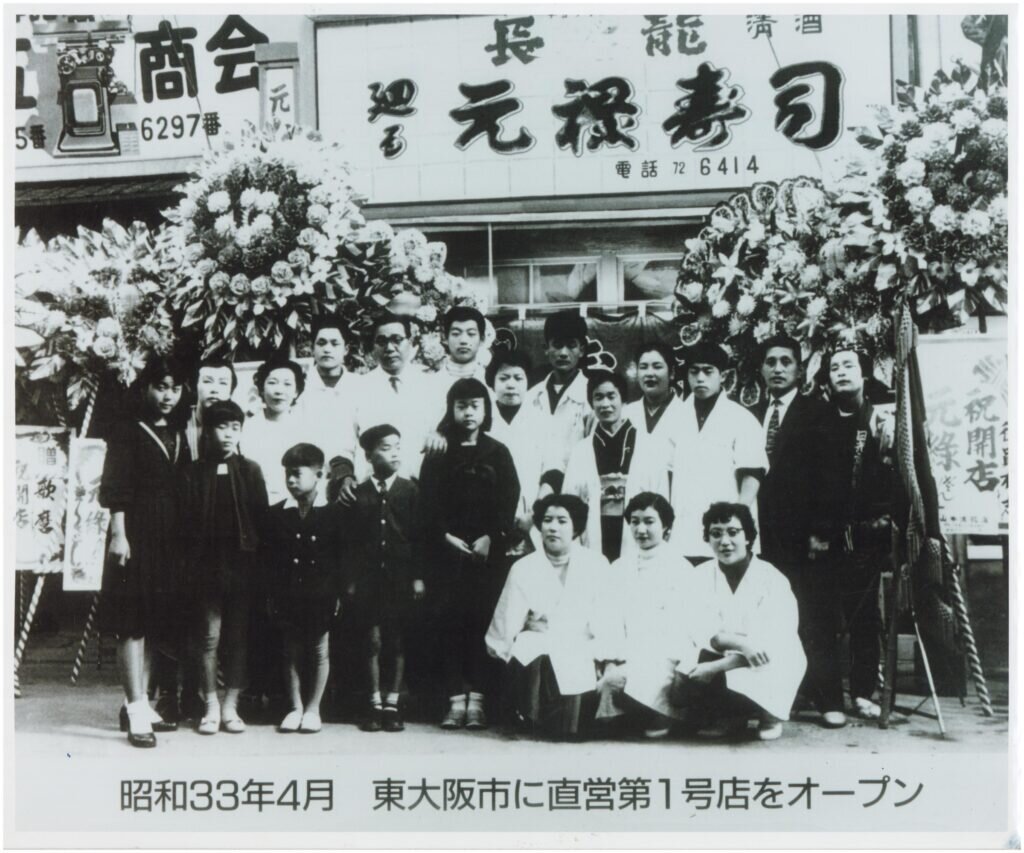
Source: Osaka Convention & Tourism Bureau https://osaka-info.jp/en/page/gastronomy-kaitenzushi
Two of these remarkable inventions are related to something that has been associated with Osaka for hundreds of years: food. One invention is the idea of the conveyor belt sushi restaurant, which was first conceived by Shiraishi Yoshiaki in the 1950s.[102] After a series of inventions that never took off, the man from Ehime was inspired by a visit to the Asahi brewery in Suita, where he saw conveyor belts used in the bottling process.[103] He realised the potential of this system as a means to reduce labour costs and customers’ waiting time in his small sushi restaurant, Genroku Sushi in Higashiosaka City. After years of preparation – adjusting the speed and enabling the conveyor belt to go around corners was particularly challenging – he introduced the system in 1958. It proved extremely popular in Osaka, and after Shiraishi showed off the system at Expo ’70, the idea took off nationwide, together with other specialities of Osaka cuisine.[104] As well as being useful for managers of understaffed restaurants, the concept was welcomed by customers who enjoyed the novelty of the system and the low costs made possible by it. In the following decades, conveyor belt sushi restaurants became widespread throughout Japan and, especially recently, around the world.
Another innovative food product unveiled in the very same year, 1958, was instant noodles. Similar to Shiraishi’s conveyor belt, instant noodles were not the first business idea of entrepreneur Ando Momofuku, founder of Nissin Food.[105] Born in Taiwan in 1910, Ando ran a number of different companies before and after his postwar move to Osaka. He was in his mid-forties when a credit union he ran – having been encouraged to move into finance despite his lack of experience – fell apart in 1957. This caused him to lose nearly all of his assets, but it also gave him the opportunity to work on his new idea of instant noodles. According to Ando’s autobiography, his initial inspiration was an experience in early postwar Osaka, when he saw a long line of cold, hungry people waiting at a ramen stall; this made him want to produce a tasty, low-cost meal that could be easily prepared.[106] When Ando first released his new product, Chicken Ramen, it was not as inexpensive as he had hoped, as the cost of the flavouring ingredients resulted in what was, at the time, a luxury item.[107] Therefore, Chicken Ramen’s initial success was limited, but following a trip to the United States, Ando developed Cup Noodle, a new version released in 1971 that came in a disposable cup, and was a huge hit after a high-profile hostage incident resulted in the Japanese public watching police officers consume large quantities of the noodles on television.[108] Instant noodles soon became a standard budget meal and emergency ration, and in time they became popular overseas too. In 2005, when Ando was in his nineties, a version of his noodles was even eaten in space. His ideas and life story continue to inspire people today, with a museum operating in his adopted hometown of Ikeda, and a major TV drama series based on his life airing between 2018 and 2019.[109]
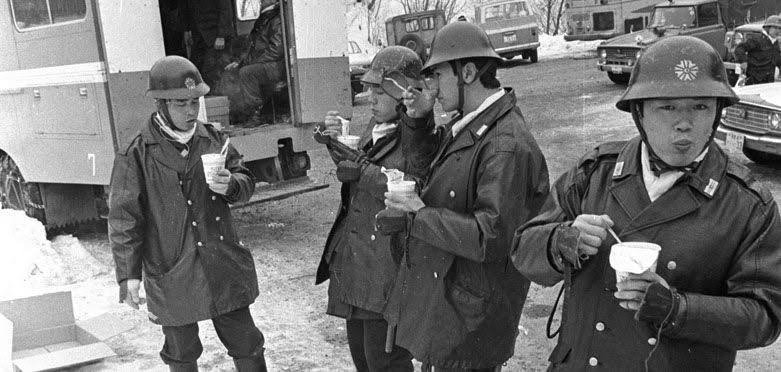
Source: Wikipedia https://commons.wikimedia.org/wiki/File:Asama_Sanso_incident.jpg
Unlike Shiraishi and Ando, the next inventor did not personally enjoy great success with his idea. This is Inoue Daisuke, the man credited with creating karaoke. Inoue was born in Osaka in 1940, and moved back and forth between the city and the suburbs during his early childhood, as Osaka and his father’s business were affected by the impact of the war.[110] He developed an interest in music during junior high school and, after a brief stint at a securities company, he went into music full-time as a drummer and keyboard player. The idea for the karaoke machine came after a local businessman approached Inoue at a Kobe club and asked for a tape recording of backing tracks to sing along with.[111] Inoue soon enlisted the help of a friend to produce a coin-operated machine with a microphone, a tape player and an amplifier. The machine was first sold to ten local bars in 1971, and after a slow start, the phenomenon spread throughout Kobe. Inoue did not foresee the popularity that the idea would gain, and never patented the invention, believing it would never catch on outside of the Kansai area. Of course, karaoke ended up becoming massively popular all over Japan and beyond, and while Inoue no longer profited from his karaoke company after passing on control to his brother, he was lifted from obscurity in 1999 when Time Magazine suddenly named him one of the most influential Asian people of the 20th century.[112] Since then, his invention earned him a prize and an extended standing ovation from the Ig Nobel awards – satirical prizes for strange achievements – and he became the subject of a biopic in 2005.[113] Whereas other ideas made their inventors rich and famous, Inoue’s wealth was moderate and his fame only came eventually, but as a now-ubiquitous form of entertainment across Japan, karaoke is perhaps just as impactful as other inventions.
After a night of karaoke, partygoers may find themselves struggling to catch the last train home and avoid a hefty taxi fare – especially when returning to the suburbs. Another 1970s invention offered a solution for office workers needing somewhere to stay between a night out and the next day’s work: the capsule hotel. The first such hotel was the Capsule Inn in the Umeda area of Osaka, opened in 1979, and it was designed by Kurokawa Kisho, a leading architect of the Metabolist school, whose previous projects had advanced the “capsule” idea in various forms.[114] Though Kurokawa and his projects were largely based in Tokyo, he was also one of several Metabolist architects who had worked on the structures used at Expo ’70 in Osaka.[115] The Capsule Inn is said to have been inspired by Kurokawa’s experience in Osaka’s slum areas; while the timing may not have been right for this version of events, it is possible that later capsule hotel businesses were responding to the need for cheap accommodation after the economic downturn in the late 1980s. The concept was popularised at this time, spreading around Japanese cities. Though they originally catered mostly to businesspeople, newer capsule hotels have also targeted budget-conscious travellers, especially in cities with limited space for holiday accommodation.[116] The idea has also spread to other countries, where capsule hotels or similar facilities have emerged especially near international airports.[117] While many people who have used capsule hotels find the experience uncomfortable, possibly limiting its potential overseas, it is unsurprisingly an influential concept that can be used as a solution to many different problems.
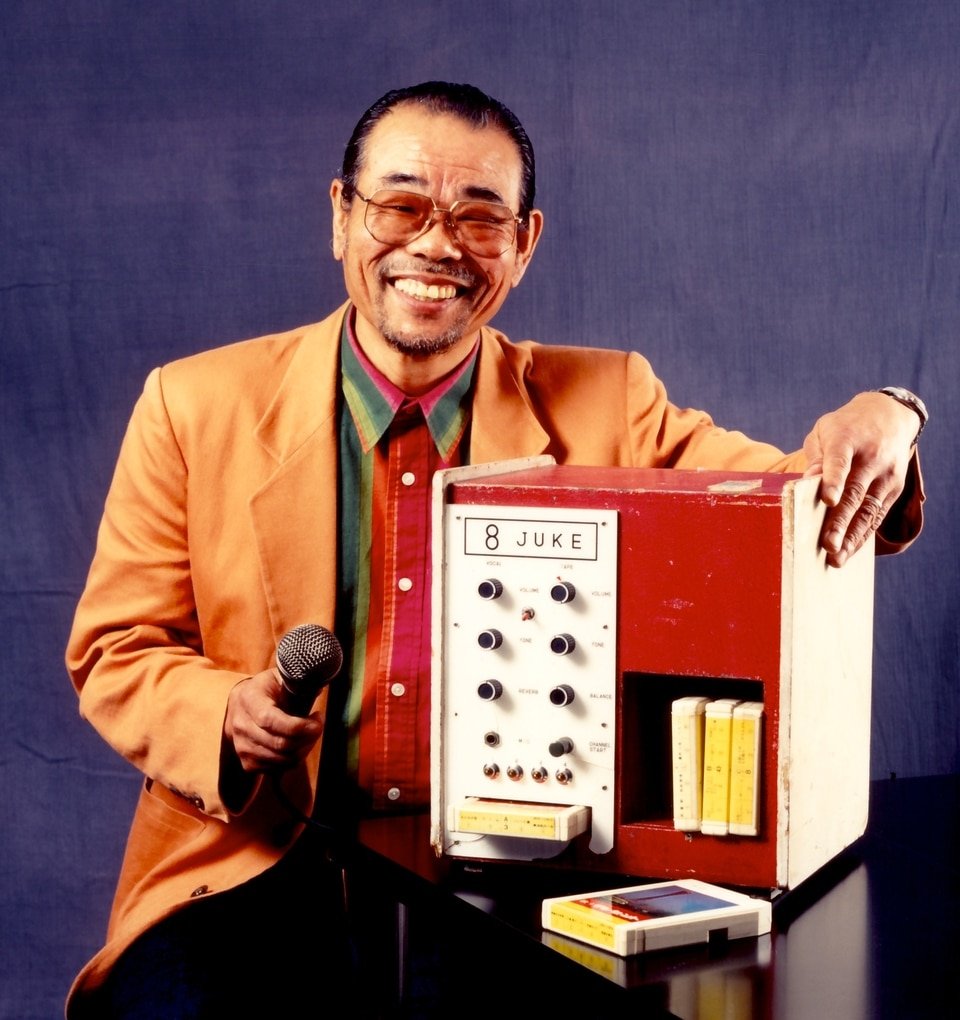
Source: The Appendix http://theappendix.net/issues/2013/10/voice-hero-the-inventor-of-karaoke-speaks
Considering this small selection of popular Osaka inventions, we can see a tendency for these ideas to offer convenience or amusement, and typically at a lower cost than alternatives. This fits in with some of the most popular ideas about Osaka people and culture: fun and good-natured, but also impatient and stingy.[118] This is, of course, a cliché, but it may provide some explanation as to why these innovations would emerge or first find an audience in the Osaka area. In any case, they all display a sense of creativity that does not always make a success of their inventors, but often has the power to inspire people in Japan and elsewhere.
Summary and Conclusions
There are several possible ways to look at a place’s economic history, for example, by examining statistics over time. However, Osaka has an extremely long history, going back to many hundreds of years before the city as we know it came into existence. This is one reason to avoid focusing on figures, and to instead explore other aspects of Osaka’s economic life over the years. In ancient Japan, Naniwa was vital to the nation’s politics, diplomacy and trade, starting the area’s association with the merchant community. Before and during the Edo Period, merchants were one of Japan’s four main classes, under a system that placed the merchants at the bottom but also provided them with the opportunity to gain wealth and social power. During this time, institutions emerged in Osaka that set the stage for the development of modern Japan’s banking system. In modern Japan, Osaka was a major industrial city, and many innovative figures explored new ideas, producing great inventions and building business empires. In more recent years, the city has suffered from economic problems affecting all of Japan, as well as the trend of companies shifting operations to Tokyo or overseas. On the other hand, there are companies in some newer or growing industries still based in Osaka, and potential for further expansion in areas such as tourism.
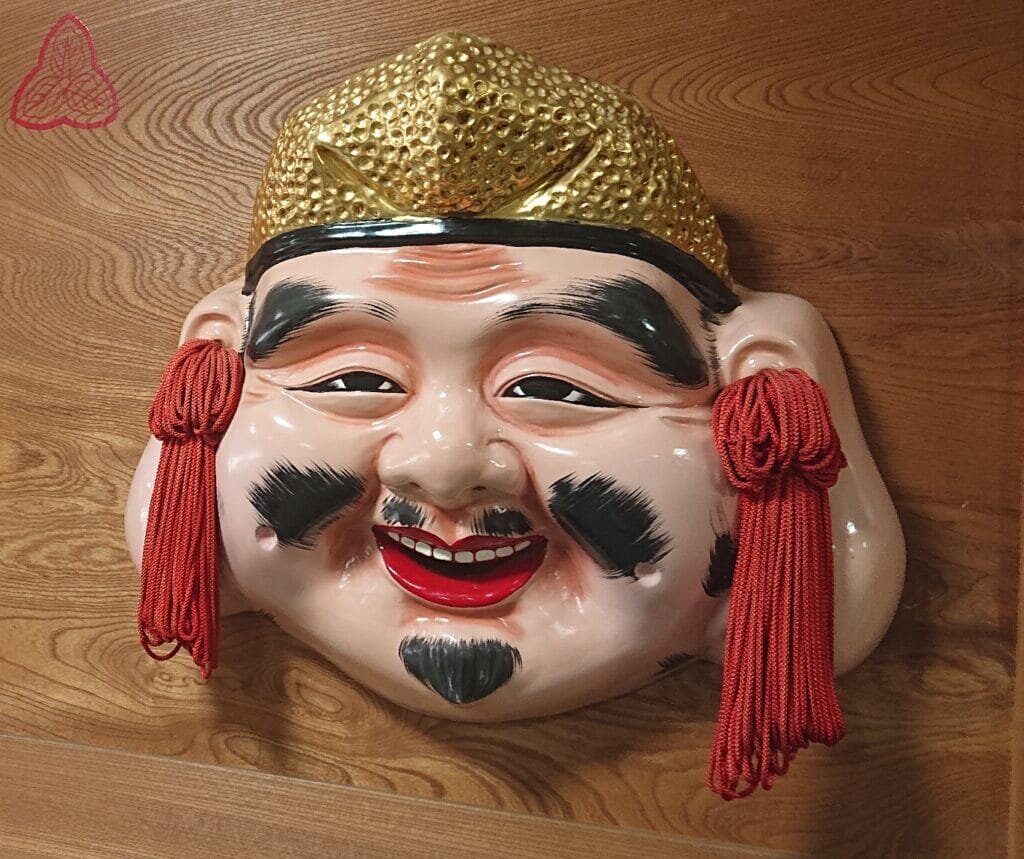
As somewhere where mercantile culture and industry are so closely intertwined with the city’s image, Osaka’s economic history has a lot to teach us. At a time when many bemoan the downward trends of the last few decades and seek to revitalise Osaka’s economy, it can be instructive to look at what has happened there in the past. If initiatives like Expo 2025 succeed in showing off the city’s history – including recent history – of trade, culture and creativity, then they may well help in improving Osaka’s fortunes.
Except where otherwise noted, graphics are by Rachel Stewart (https://www.rachelstewartphd.com/) and other images are photographs taken by the author.
[1] ‘An Introduction to Osaka’s Unique and Cherished Dialect’. Osaka Convention & Tourism Bureau.
https://osaka-info.jp/en/page/osaka-dialect
[2] Black, J, 2017. ‘Osaka Ports and Shipping – Institutions and Organisations from Ancient Times to the Meiji Restoration’. University of Oxford.
https://www.tsu.ox.ac.uk/events/170214.pdf
[3] 2019. ‘Beautification of the Yodogawa River Landscape’. Osaka Prefecture official website.
http://www.pref.osaka.lg.jp/attach/34342/00319640/yodogawa_English%20P1-P11.pdf
[4] ‘Historical Overview’. Osaka City official website.
https://www.city.osaka.lg.jp/contents/wdu020/enjoy/en/overview/content_Historical_overview.html
[5] ‘Sumiyoshi Grand Shrine’. Temples and Shrines of Kansai.
https://konicyan13.sakura.ne.jp/sumiyositaisya4.html
[6] Sakaehara, T, 2008. ‘The port of Osaka: From ancient times to today’. In: Graf, A and Huat, CB, ed. Port Cities in Asia and Europe. Routledge.
[7] ‘Watanabe no Tsu (Watanabe Port)’. Japanese Wiki Corpus.
https://japanese-wiki-corpus.github.io/geographical/Watanabe%20no%20Tsu%20(Watanabe%20Port).html
[8] Pearson, R, 2016. ‘Japanese medieval trading towns: Sakai and Tosaminato’. Japanese Journal of Archaeology.
http://www.jjarchaeology.jp/contents/pdf/vol003/3-2_089-116.pdf
[9] Adika, A, 2015. ‘Sakai: a keyhole to the history of Osaka’. The Japan Times.
https://www.japantimes.co.jp/life/2015/04/11/travel/sakai-keyhole-history-osaka/#.Vr2JV_krJjU
[10] 2017. ‘Ishiyama Hongan-ji Temple: The Temple that Created Osaka’. Kansai Odyssey.
http://kansai-odyssey.com/the-temple-that-created-osaka-ishiyama-hongan-ji-temple/
[11] Kawai, A, 2020. ‘Toyotomi Hideyoshi’s Japan: Taking Control of the State’. Nippon.com.
https://www.nippon.com/en/japan-topics/b06906/
[12] Graham, P, Yiengpruksawan, M and Miura, M, 2003. ‘Osaka’. Grove Art Online.
[13] Szczepanski, K, 2019. ‘The Four-Tiered Class System of Feudal Japan’. ThoughtCo History & Culture.
https://www.thoughtco.com/four-tiered-class-system-feudal-japan-195582
[14] ‘Osaka’. The Samurai Archives.
https://wiki.samurai-archives.com/index.php?title=Osaka
[15] Tsukada, T and Yagi, S, 2020. ‘Early Modern Osaka from the Documents: An Overview of Early Modern Osaka’s History’. Osaka City University.
https://www.lit.osaka-cu.ac.jp/MSGEM/research/early-modern-osaka-from-the-documents-2/
[16] Sheldon, C, 1983. ‘Merchants and Society in Tokugawa Japan’. Modern Asian Studies.
https://www.jstor.org/stable/312302
[17] ‘Markets in Osaka’. The National Diet Library.
https://www.ndl.go.jp/scenery/e/column/kansai/markets_in_osaka.html
[18] ‘Historical Overview’. Osaka Convention & Tourism Bureau.
https://osaka-info.jp/en/page/osaka-history
[19] Hashizume, S, 2019. ‘A History of Osaka, Japan’s City of Water’. Nippon.com.
https://www.nippon.com/en/japan-topics/g00681/a-history-of-osaka-japan%E2%80%99s-city-of-water.html
[20] 2011. ‘Fifth National Industrial Exposition’. The National Diet Library.
https://www.ndl.go.jp/exposition/e/s1/naikoku5.html
[21] 2019. ‘East and West Commerce Centers: Comparing Osaka and Tokyo’. Nippon.com.
[22] De Ferranti, H, 2009. ‘Music and Diaspora in the Second Metropolis: The Okinawan and Korean Musicians of Interwar Osaka’. Japanese Studies.
https://www.tandfonline.com/doi/full/10.1080/10371390903066665
[23] Kawato, A, 2007. ‘Japanese economy has a long history—Osaka’s example’. Japan-World Trends.
http://www.japan-world-trends.com/en/japan_diary/japanese_economy_has_a_long_hi.php
[24] ‘Osaka Army Arsenal’. The National Diet Library.
https://www.ndl.go.jp/scenery/e/column/kansai/osaka_army_arsenal.html
[25] Official Statistics of Japan Census Statistics.
https://www.e-stat.go.jp/stat-search/files?page=1&toukei=00200521&result_page=1
[26] Okazaki, T, 2015. ‘Lessons from the Japanese Miracle: Building the Foundations for a New Growth Paradigm’. Nippon.com.
https://www.nippon.com/en/in-depth/a04003/
[27] Johnston, E, 2020. ‘The 1970 Osaka Expo: Looking back at the past to gauge where Japan sits in the present’. The Japan Times.
[28] Shimizu, M, 2019. ‘Impact of Industrialisation on Cities in Japan: The Past and Future of Osaka’. In: Shiriashi, K and Matoba, N, ed. Depopulation, Deindustrialisation and Disasters: Building Sustainable Communities in Japan. Palgrave Macmillan.
https://link.springer.com/chapter/10.1007/978-3-030-14475-3_10
[29] Johnston, E, 2015. ‘Governor and mayor push for Osaka to become Japan’s vice capital’. The Japan Times.
[30] 2020. ‘Osaka metropolis plan rejected by slim margin in 2nd referendum’. Kyodo News.
[31] Hashizume, S, 2020. ‘Expo 1970 Osaka: the story of Japan’s first World Expo’. Bureau International des Expositions.
https://www.bie-paris.org/site/en/focus/entry/expo-1970-osaka-the-story-of-japan-s-first-world-expo
[32] Hauser, W, 1977. ‘Osaka: A Commercial City in Tokugawa Japan’. Urbanism Past & Present.
https://www.jstor.org/stable/44403551
[33] ‘Rice and the Economy’. Sumitomo Group Public Affairs Committee.
https://www.sumitomo.gr.jp/english/history/s_history/rice/
[34] West, M, 2000. ‘Private Ordering at the World’s First Futures Exchange’. Michigan Law Review.
https://www.jstor.org/stable/1290356
[35] Moss, D and Kintgen, E, 2010. ‘The Dojima Rice Market and the Origins of Futures Trading’. Harvard Business School.
https://www.hbs.edu/faculty/Pages/item.aspx?num=36846
[36] Trevor, T, 2015. ‘Ulrike Shaede – The Origin of Futures [Osaka]’. TomTrevor.net.
https://tomtrevor.net/2015/12/18/ulrike-schaede-the-origin-of-futures/
[37] Ishizu, M, 2020. ‘“Money Markets and Trade” Defining Provincial Financial Agents in England and Japan’. The London School of Economic and Political Science.
http://eprints.lse.ac.uk/103159/1/WP305.pdf
[38] Crawcour, S, 1961. ‘The Development of a Credit System in Seventeenth-Century Japan’. The Journal of Economic History.
https://www.jstor.org/stable/2115405
[39] Shizume, M and Tsurumi, M, 2016. ‘Modernizing the financial system during the 19th century: National Banks in Japan in the Context of Free Banking’. Waseda Institute of Political Economy.
https://www.waseda.jp/fpse/winpec/assets/uploads/2016/09/No.E1607Shizume_Tsurumi.pdf
[40] Tamaki, N, 2005. Japanese Banking: A History, 1859-1959. Cambridge University Press.
[41] ‘Sumitomo’s starting point’. Sumitomo Group Public Affairs Committee.
https://www.sumitomo.gr.jp/english/history/point/
[42] ‘About our founder Tokushichi Nomura’. Nomura Holdings.
https://www.nomuraholdings.com/company/basic/founder/all.pdf
[43] ‘History’. Japan Mint official website.
https://www.mint.go.jp/eng/profile-eng/eng_guide_history.html
[44] 2009. ‘Origin story of the Mint Bureau’. Osaka City official website.
https://www.city.osaka.lg.jp/kita/cmsfiles/contents/0000038/38804/02.pdf
[45] Mizuta, S, 2019. ‘Making a Mint: British Mercantile Influence and the Building of the Japanese Imperial Mint’. Architectural History.
[46] 2012. ‘Biographies: Godai Tomoatsu’. Japan Reference.
https://jref.com/articles/godai-tomoatsu.129/
[47] 2018. ‘Regional Information: Osaka’. Japan External Trade Organization.
https://www.jetro.go.jp/en/invest/region/osaka/
[48] Schumacher, M. ‘Shotoku Taishi’. Japanese Buddhist Statuary.
http://www.onmarkproductions.com/html/shotoku-taishi.html
[49] Herrera, I, 2014. ‘Building on Tradition – 1,400 Years of a Family Business’. Works That Work.
https://worksthatwork.com/3/kongo-gumi
[50] ‘Kongo-Gumi Co., Ltd’. Takamatsu Construction Group.
https://www.takamatsu-cg.co.jp/eng/about/group/takamatsu/kongogumi.html
[51] Barr, J, 2017. ‘Zenecon: The Japanese Construction Phenomenon’. John Barr Architects.
https://www.johnbarrarchitect.com/post/2017/05/01/zenecon-the-japanese-construction-phenomenon
[52] 2020. ‘Obayashi Corporation’. Encyclopedia.com.
https://www.encyclopedia.com/books/politics-and-business-magazines/obayashi-corporation
[53] ‘History’. Obayashi Corporation.
https://www.obayashi.co.jp/en/company/history.html
[54] ‘Development’. Obayashi Corporation.
https://www.obayashi.co.jp/company/history/index.html
[55] ‘Takenaka by numbers’. Takenaka Corporation.
https://www.takenaka.co.jp/takenaka_e/about/numbers/
[56] ‘History’. Takenaka Corporation.
https://www.takenaka.co.jp/takenaka_e/about/archive/
[57] Schonherr, J. ‘Kamagasaki’. Japan Visitor.
https://www.japanvisitor.com/osaka/kamagasaki
[58] ‘Kansai Private Railways’. Kansai Odyssey.
http://kansai-odyssey.com/kansai-private-railways/
[59] ‘History of Nankai’. Nankai Electric Railway.
https://www.howto-osaka.com/en/company/
[60] ‘Shopping street History’. Ebisubashisuji Promotion Union.
https://www.ebisubashi.or.jp/en/about.html
[61] ‘Nankai Building’. Agency for Cultural Affairs Designated Cultural Property Database.
https://kunishitei.bunka.go.jp/heritage/detail/101/00008513
[62] Miki, R and Ieda, H, 2019. ‘“Side-Business” Development in Japanese Major Private Passenger Railways’. Transportation Research Procedia.
https://www.sciencedirect.com/science/article/pii/S2352146520304312
[63] Lambe, M. ‘The History of Osaka and Osaka-Umeda Stations’. Osaka Station Guide.
https://www.osakastation.com/the-history-of-osaka-umeda-stations/
[64] Semple, A, 2009. ‘The influence of Hankyu and Hanshin private railway groups on the urban development of the Hanshin region, Japan’. University of New South Wales.
http://unsworks.unsw.edu.au/fapi/datastream/unsworks:5114/SOURCE1?view=true
[65] ‘Koshien Stadium’. Japan National Tourism Organization.
https://www.japan.travel/en/spot/2355/
[66] Hall, K, 2018. ‘Baseball fans of a wildly different stripe’. Nikkei Asia.
https://asia.nikkei.com/Life-Arts/Life/Baseball-fans-of-a-wildly-different-stripe
[67] Ogawa, I, 1998. ‘History of Amusement Park Construction by Private Railway Companies in Japan’. Japan Railway & Transport Review.
https://www.ejrcf.or.jp/jrtr/jrtr15/pdf/f28_oga.pdf
[68] Kamitani, C, 2014. ‘A Century of Dreams and Romance: A History of Japan’s All-Female Takarazuka Revue’. Nippon.com.
https://www.nippon.com/en/views/b03901/
[69] ‘Toho Motion Picture Company’. Encyclopædia Britannica.
https://www.britannica.com/topic/Toho-Motion-Picture-Company
[70] Turner, D, 2006. ‘Hanshin Electric agrees to Hankyu offer’. Financial Times.
https://www.ft.com/content/2d4d4572-eecb-11da-820a-0000779e2340
[71] ‘Hankyu Hanshin Toho Group’. H2O Retailing Corporation.
https://www.h2o-retailing.co.jp/en/company/hhtg.html
[72] 2019. ‘Kansai railways branch out into new businesses to head off depopulation’. The Japan Times.
[73] Mathies, U, 2016. ‘Panasonic: A Case Study on Constant Change and Reinvention of a World Brand’. In: Segers, R, ed. Multinational Management: A Casebook on Asia’s Global Market Leaders. Springer.
[74] ‘Corporate history: 1927’. Panasonic official website.
https://www.panasonic.com/global/corporate/history/chronicle/1927.html
[75] Gordon, S, 2003. ‘“Panasonic” takes centre stage as “National” brand retired”’. EE Times.
https://www.eetimes.com/panasonic-takes-centre-stage-as-national-brand-retired/
[76] Takenaka, K and Layne, N, 2008. ‘Panasonic to buy Sanyo, more deals may follow’. Reuters.
[77] 2008. ‘Matsushita Electric Becomes Panasonic Corporation’. Panasonic official website.
https://news.panasonic.com/global/press/data/en081001-4/en081001-4.html
[78] 2012. ‘Sharp 100th Anniversary: Chapter 1’. Sharp official website.
http://global.sharp/corporate/img/info/his/h_company/pdf_en/chapter01.pdf
[79] 2012. ‘Sharp 100th Anniversary: Chapter 2’. Sharp official website.
http://global.sharp/corporate/img/info/his/h_company/pdf_en/chapter02.pdf
[80] ‘Product Story’. Sharp official website.
http://global.sharp/corporate/info/his/only_one/
[81] Iiyama, J, 2017. ‘Era over as Sharp’s former headquarters meets wrecking ball’. Nikkei Asia.
https://asia.nikkei.com/Business/Era-over-as-Sharp-s-former-headquarters-meets-wrecking-ball
[82] Provo, F, 2004. ‘The History of SNK’. Gamespot.
https://www.gamespot.com/articles/the-history-of-snk/1100-6089278/
[83] 2019. ‘History’. Capcom official website.
http://www.capcom.co.jp/ir/english/company/history.html
[84] Stuart, K, 2009. ‘SNK Playmore: a brief profile and interview’. The Guardian.
https://www.theguardian.com/technology/gamesblog/2009/jan/05/gameculture-playstation
[85] 2016. ‘Announcement regarding SNK PLAYMORE’s Corporate Logo & Slogan Changes’. SNK Playmore official website (archive).
https://web.archive.org/web/20160603120950/http://www.snkplaymore.co.jp/us/press/pdf/160425_1.pdf
[86] 2020. ‘Profits Hit Record-High for Third Consecutive Year Driven by Digital Contents Business in Consolidated Results for the Year Ended March 2020’. Capcom official website.
http://www.capcom.co.jp/ir/english/news/html/e200508b.html
[87] 2017. ‘Consumption of Beer’. Statistics Japan.
https://stats-japan.com/t/kiji/10822
[88] 2012. ‘The Story of Sake Brewing in the Kansai Region’. Museum of Osaka University.
http://www.osaka-u.ac.jp/en/news/seminar/2012/10/5267
[89] ‘The History of Shirayuki and Sake’. Konishi Brewing.
http://www.konishi.co.jp/html/e/history.html
[90] ‘History of sake’. Japan Sake and Shochu Makers Association.
https://www.japansake.or.jp/sake/english/pdf/no_10.pdf
[91] Gauntner, J, 1999. ‘Osaka still has reasons to be proud of its brewing culture’. The Japan Times.
[92] 2017. ‘Consumption of Sake’. Statistics Japan.
https://stats-japan.com/t/kiji/10817
[93] ‘Asahi Group’s History’. Asahi Group Holdings.
https://www.asahigroup-holdings.com/en/whoweare/history.html
[94] Cornell, M, 2019. ‘A short history of Asahi, in which beer gets called “bitter horse-piss wine”’. Zythophile.
[95] 2019. ‘Factbook 2019’. Asahi Group Holdings.
https://www.asahigroup-holdings.com/en/ir/pdf/2019_2q_factbook.pdf#zoom=100
[96] ‘History: Digest’. Suntory Holdings.
https://www.suntory.com/about/history/index.html
[97] ‘The Founder’. Nikka Whisky official website.
https://www.nikka.com/eng/story/founder/
[98] ‘Suntory Whisky’. Dekanta.
https://dekanta.com/distilleries/suntory-whisky/
[99] ‘Nikka Whisky’. Asahi Group Holdings.
https://www.asahigroup-holdings.com/en/brand/nikka/
[100] 2014. ‘Suntory Holdings to Acquire Beam in $16 Billion Transaction’. Suntory Holdings.
https://www.suntory.com/news/2014/11942.html
[101] ‘History and Development’. Asahi Group Holdings.
https://www.asahigroup-holdings.com/company/history/
[102] Joy, A, 2017. ‘The Unlikely Inventor of Kaiten Sushi’. Culture Trip.
https://theculturetrip.com/asia/japan/articles/the-unlikely-inventor-of-kaiten-sushi/
[103] Magnier, M and Ueno, H, 2001. ‘Yoshiaki Shiraishi; Founded Conveyor Belt Sushi Industry’. Los Angeles Times.
https://www.latimes.com/archives/la-xpm-2001-sep-02-me-41354-story.html
[104] ‘Conveyor belt sushi’. Osaka Convention & Tourism Bureau.
https://osaka-info.jp/en/page/gastronomy-kaitenzushi
[105] Yamaguchi, N, 2018. ‘Ando Momofuku: An Inventor Who Used His Noodle to Change Global Food Culture’. Nippon.com.
https://www.nippon.com/en/views/b07206/
[106] Hevesi, D, 2007. ‘Momofuku Ando, 96, Dies; Invented Instant Ramen’. The New York Times.
https://www.nytimes.com/2007/01/09/business/worldbusiness/09ando.html
[107] Rainford, B, 2019. ‘From Luxury to Low-cost: The Globalization of Instant Noodles’. Emory University.
[108] Murai, S, 2016. ‘Cup Noodles slurping strong, 45 years on’. The Japan Times.
https://www.japantimes.co.jp/news/2016/08/22/reference/cup-noodles-slurping-strong-45-years/
[109] Pierce, M, 2020. ‘Cupnoodles Museum Osaka Ikeda’. QAZ Japan.
https://qazjapan.com/dive/cupnoodles-museum/
[110] Ryall, J, 2020. ‘He invented karaoke, saw it take off, then walked away – Daisuke Inoue taught the world to sing, if not always in harmony’. South China Morning Post.
[111] Madrigal, A, 2013. ‘Someone Had to Invent Karaoke – This Guy Did’. The Atlantic.
[112] McNeill, D, 2005. ‘Mr. Song and Dance Man’. The Asia-Pacific Journal.
https://apjjf.org/-David-McNeill/1833/article.html
[113] Woodward, W, 2004. ‘Nobels oblige’. The Guardian.
https://www.theguardian.com/education/2004/oct/05/research.science
[114] Arkaraprasertkul, N, 2015. ‘In Praise of the “Coffin”: Urban Sociality in the Japanese Capsule Hotels’. In: Wong, H, Pan, L and Chau, K, ed. Politics and Aesthetics of Creativity: City, Culture and Space in East Asia. Bridge21.
[115] ‘Expo ’70 (Toshiba IHI Pavilion, Takara Beautilion, Theme Pavilion)’. Kisho Kurokawa Architect and Associates.
https://www.kisho.co.jp/page/211.html
[116] 2017. ‘Capsule hotels appeal to female history buffs, foreign visitors’. Japan Today.
[117] Drescher, C, 2016. ‘How Capsule Hotels Became a Global Trend’. Condé Nast Traveler.
https://www.cntraveler.com/stories/2016-06-10/how-capsule-hotels-became-a-global-trend
[118] Inoue, Y, 2019. ‘Osaka: Beyond Stereotypes’. Nippon.com.
https://www.nippon.com/en/japan-topics/g00612/osaka-beyond-stereotypes.html





















